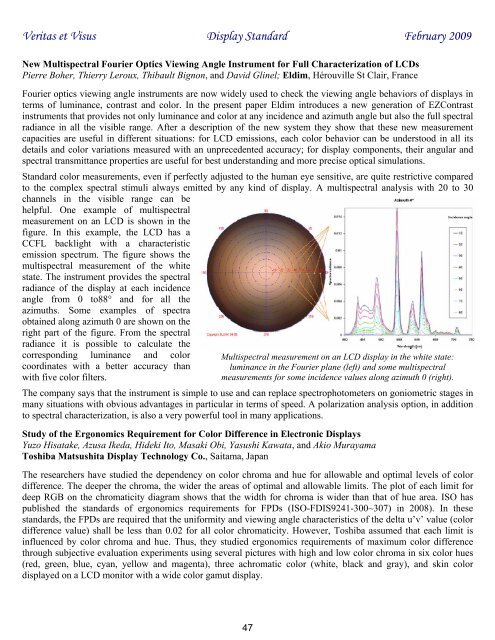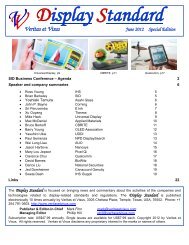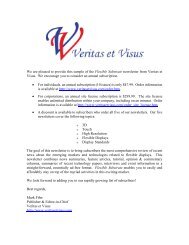You also want an ePaper? Increase the reach of your titles
YUMPU automatically turns print PDFs into web optimized ePapers that Google loves.
<strong>Veritas</strong> <strong>et</strong> <strong>Visus</strong> <strong>Display</strong> <strong>Standard</strong> February 2009<br />
New Multispectral Fourier Optics Viewing Angle Instrument for Full Characterization of LCDs<br />
Pierre Boher, Thierry Leroux, Thibault Bignon, and David Glinel; Eldim, Hérouville St Clair, France<br />
Fourier optics viewing angle instruments are now widely used to check the viewing angle behaviors of displays in<br />
terms of luminance, contrast and color. In the present paper Eldim introduces a new generation of EZContrast<br />
instruments that provides not only luminance and color at any incidence and azimuth angle but also the full spectral<br />
radiance in all the visible range. After a description of the new system they show that these new measurement<br />
capacities are useful in different situations: for LCD emissions, each color behavior can be understood in all its<br />
d<strong>et</strong>ails and color variations measured with an unprecedented accuracy; for display components, their angular and<br />
spectral transmittance properties are useful for best understanding and more precise optical simulations.<br />
<strong>Standard</strong> color measurements, even if perfectly adjusted to the human eye sensitive, are quite restrictive compared<br />
to the complex spectral stimuli always emitted by any kind of display. A multispectral analysis with 20 to 30<br />
channels in the visible range can be<br />
helpful. One example of multispectral<br />
measurement on an LCD is shown in the<br />
figure. In this example, the LCD has a<br />
CCFL backlight with a characteristic<br />
emission spectrum. The figure shows the<br />
multispectral measurement of the white<br />
state. The instrument provides the spectral<br />
radiance of the display at each incidence<br />
angle from 0 to88° and for all the<br />
azimuths. Some examples of spectra<br />
obtained along azimuth 0 are shown on the<br />
right part of the figure. From the spectral<br />
radiance it is possible to calculate the<br />
corresponding luminance and color<br />
coordinates with a b<strong>et</strong>ter accuracy than<br />
with five color filters.<br />
Multispectral measurement on an LCD display in the white state:<br />
luminance in the Fourier plane (left) and some multispectral<br />
measurements for some incidence values along azimuth 0 (right).<br />
The company says that the instrument is simple to use and can replace spectrophotom<strong>et</strong>ers on goniom<strong>et</strong>ric stages in<br />
many situations with obvious advantages in particular in terms of speed. A polarization analysis option, in addition<br />
to spectral characterization, is also a very powerful tool in many applications.<br />
Study of the Ergonomics Requirement for Color Difference in Electronic <strong>Display</strong>s<br />
Yuzo Hisatake, Azusa Ikeda, Hideki Ito, Masaki Obi, Yasushi Kawata, and Akio Murayama<br />
Toshiba Matsushita <strong>Display</strong> Technology Co., Saitama, Japan<br />
The researchers have studied the dependency on color chroma and hue for allowable and optimal levels of color<br />
difference. The deeper the chroma, the wider the areas of optimal and allowable limits. The plot of each limit for<br />
deep RGB on the chromaticity diagram shows that the width for chroma is wider than that of hue area. ISO has<br />
published the standards of ergonomics requirements for FPDs (ISO-FDIS9241-300~307) in 2008). In these<br />
standards, the FPDs are required that the uniformity and viewing angle characteristics of the delta u’v’ value (color<br />
difference value) shall be less than 0.02 for all color chromaticity. However, Toshiba assumed that each limit is<br />
influenced by color chroma and hue. Thus, they studied ergonomics requirements of maximum color difference<br />
through subjective evaluation experiments using several pictures with high and low color chroma in six color hues<br />
(red, green, blue, cyan, yellow and magenta), three achromatic color (white, black and gray), and skin color<br />
displayed on a LCD monitor with a wide color gamut display.<br />
47






